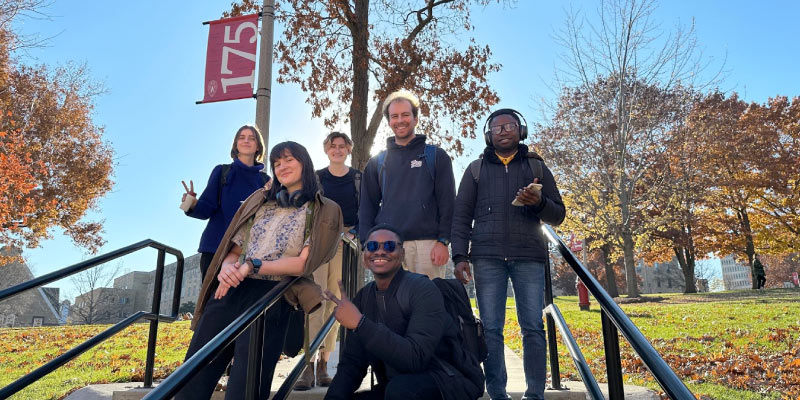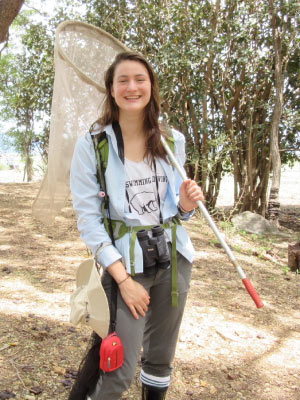
For Linnea Patterson, studying biology was — well, in her biology. With both her parents and stepdad working as biologists, it was a good bet that she would want to follow in her family’s footsteps. “I grew up in a family of enthusiastic biologists,” Patterson said, “which likely influenced getting my degree in Biology and Environmental Studies from Bowdoin College, which is a small liberal arts school in Brunswick, Maine.”
As Patterson attended Bowdoin College, she expanded her horizons through a summer tropical field biology program and became interested in geographic information systems (GIS), computer mapping programs that analyze and display geographic data. She then went on to take every GIS and remote sensing class that Bowdoin College had to offer which laid the foundation for her work’s motivation: using science to inform management decisions.
“One of the biggest challenges for scientists is how to communicate the data they’re observing, collecting, or analyzing to people who are in a position to use it on the ground.” Patterson said. “In order to move from science to action, you have to translate it into an accessible format that can be easily digested, and I think that maps are a great way to do that.”
After graduating from Bowdoin College in 2018, Patterson returned to work at Coastal Enterprises Inc. (CEI), a community development financial institution working to fill the gaps in the commercial financial industry and take on the perceived risk of lending when a traditional commercial bank would deny someone a loan for various reasons. “I was really into STEM courses in college and doing a lot of lab work, and then I realized I wanted something that was a bit more people and community based,” Patterson said.

Patterson worked as CEI’s Environmental Lending Specialist where she helped loan officers conduct background research on lendees and supported the expansion of solar investments in Maine— later transitioning her role into a Program Developer in Climate Justice and Environmental Resilience with a focus on helping communities and businesses participate in the green transition.
After a few years of working with CEI, Patterson hoped to return to GIS. A tip from a current UW professor and a quick online search led her to the Nelson Institute’s environmental observation and informatics (EOI) master’s program. As she read about the program’s opportunities — including an Organic Valley fellowship — she felt her heart “speed up.” That’s exactly what she wanted to do: translate science into action.
“Now I’m here in the EOI program that is really focused on applying technical tools to scientific questions,” Patterson said. “I’m really excited about how this program is going to help me prepare for a future where I can be one of the people translating science to end users.”
Patterson’s classes, especially those taught by Associate Professors Annemarie Schneider and Mutlu Özdoğan, have helped prepare her for this future by teaching her remote sensing theory and application. “Those classes have been excellent. I’ve learned a lot about remote sensing from them,” Patterson said. “[Schneider and Özdoğan] are great teachers. They’re teaching really complex concepts to people who probably haven’t encountered remote sensing before.”
As Patterson finishes the spring semester of the EOI program, she has her sights set on her summer capstone: working with Organic Valley through the Farmers Advocating for Organic (FAFO) grant program. While the details of her project are still in the works, Patterson will help Organic Valley improve a biomass modeling algorithm that gives farmers predictions on the amount of grass growing in their pastures. “I know that I’ll be helping improve how we inform farmers about what’s happening on their land and hopefully in a way that is helping them make decisions about how to optimally manage it or make long-term decisions about their fields,” Patterson said.
The EOI program’s partnership with Organic Valley aims to support a student who has the technical skills in analyzing satellite data that could support Organic Valley’s efforts. “Especially if the student also had an interest in data communication and supporting the community of farmers,” said Sarah Graves, graduate program manager. “Because of the support of Organic Valley and the FAFO program, Linnea is building her technical data analysis skills with a focus on providing valuable information to farmers.”
Patterson will graduate from the EOI program in August of 2024 and advises other students interested in science to just be curious. “I think that’s what makes a good scientist — being really curious about the problem you’re trying to solve or being curious enough to observe something that you want to know the answer to,” Patterson said.
Take Patterson’s advice to heart; she has the biology to back it up.